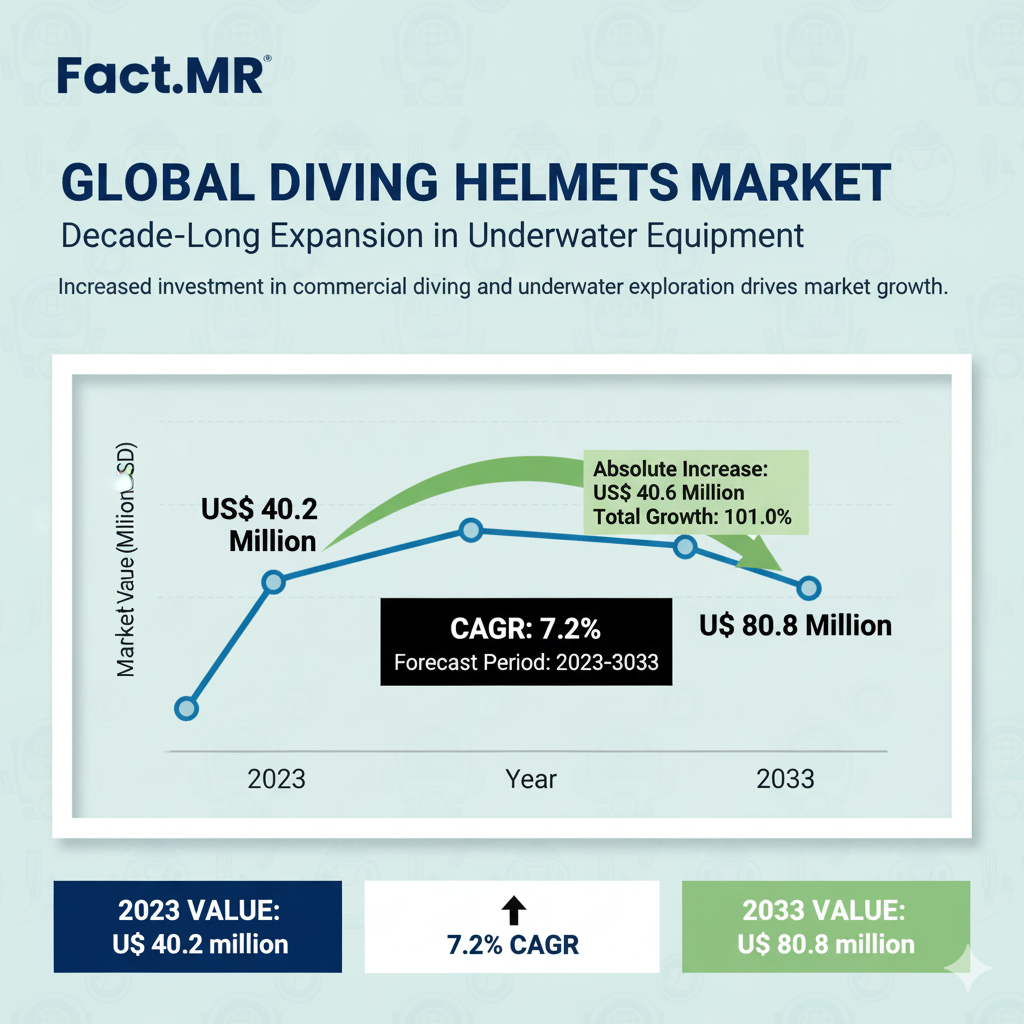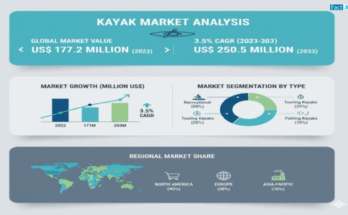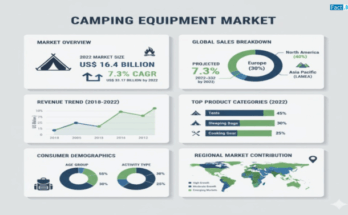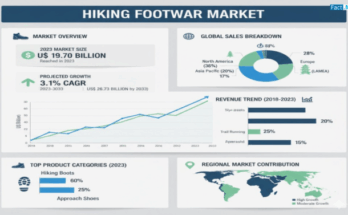Based on the analysis by Fact.MR, the global diving helmets market is estimated to be valued at US$ 40.2 Million in 2023 and it is expected to grow at a CAGR of 7.2% to reach US$ 80.8 Million by the end of 2033.
The evolution of diving helmets integrating superior comfort, enhanced communication systems, and improved visibility has positioned them as indispensable tools for underwater operations, marine research, and recreational diving. This transformation is enabling the global diving equipment sector to meet the rising demand for safety, performance, and endurance under challenging marine conditions.
Adventure Tourism and Underwater Research Driving Market Expansion:
The global surge in adventure tourism and underwater exploration is a key factor fueling diving helmet sales. The adventure tourism market, valued at US$ 288 billion in 2021, is projected to grow nearly tenfold by 2030, reaching US$ 2.8 trillion, according to industry estimates.
As more travelers seek immersive experiences such as scuba diving, snorkeling, and marine exploration, the need for reliable, advanced diving gear has increased substantially. Diving helmets with built-in air supply systems, superior protection against water pressure, and advanced communication features — are now considered essential equipment for professional divers and underwater service providers.
This shift in consumer and industrial preferences is creating lucrative opportunities for manufacturers, who are focusing on product innovation and customization to meet the diverse demands of recreational divers, defense personnel, and marine construction companies.
Technological Innovation Fuels Growth Across Marine Industries:
The Fact.MR report underscores the technological evolution of diving helmets, which now incorporate lightweight materials, balanced gas flow systems, and mixed gas capabilities for deep-sea applications. These innovations have expanded their use from traditional diving activities to offshore energy projects, underwater construction, salvage operations, and marine inspection services.
In the short term (2023–2026), the rising demand for recreational scuba diving equipment will drive sales, while the medium term (2026–2029) will witness strong demand from commercial operations and underwater research institutions. Over the long term (2029–2033), growth will be sustained by the expansion of marine industries and the increasing popularity of underwater adventure sports.
Regional Highlights: U.S. and Germany Leading the Way:
North America continues to dominate the global diving helmets market, capturing 40% of total market share in 2023. Within this region, the United States stands out as a key growth engine, projected to expand at a robust 8.1% CAGR through 2033.
The U.S. marine economy recorded a 7.4% rise in GDP contribution and a 10.5% increase in marine sector sales in 2021, according to the Office for Coastal Management. This growth is driving heightened demand for commercial diving helmets across offshore oil and gas, aquaculture, and underwater infrastructure projects.
Meanwhile, Germany represents Europe’s fastest-growing market for diving helmets. Its thriving maritime sector — encompassing offshore energy, marine research, and underwater construction — continues to fuel demand for high-quality diving gear. Germany’s stringent safety standards and technological expertise have positioned it as a hub for advanced diving equipment manufacturing and innovation.
Market Segmentation Insights: Standard Helmets Dominate:
Standard diving helmets account for the largest market share due to their affordability, versatility, and accessibility. These helmets are designed for a broad range of activities — from shallow recreational dives to deep commercial missions — and offer a balance of safety, cost-effectiveness, and ease of maintenance.
The deep diving segment, representing 70.4% of the total market share in 2023, remains the leading application area. Growing investments in underwater resource exploration, including minerals and energy reserves, have propelled the demand for advanced deep-sea diving helmets equipped with gas-mixing systems, pressure control, and communication technologies.
Challenges: High Costs and Limited Accessibility:
Despite promising growth, high production and acquisition costs remain a key restraint for the diving helmets market. Advanced models equipped with cutting-edge safety and communication systems are often expensive, limiting accessibility for smaller diving companies and recreational users.
However, this challenge is being offset by increasing demand from commercial diving contractors, offshore maintenance firms, and defense organizations, which require high-performance helmets for specialized underwater operations. As manufacturers scale production and introduce modular, cost-efficient designs, the market is expected to achieve broader penetration across user segments.
Key Players and Strategic Developments:
Leading manufacturers driving the competitive landscape include:
- DESCO Corporation
- Kirby Morgan Dive Systems, Inc.
- James Fisher and Sons PLC
- Sub Sea Systems, Inc.
- Aqualung Group
- DRASS GALEAZZI U.T. SRL
These companies are focusing on continuous research and development to enhance helmet performance, safety, and ergonomics. Strategic priorities include:
– Product Innovation: Introduction of lightweight helmets with integrated gas management systems and high-definition underwater communication.
– Diversification: Expansion of product portfolios to cater to defense, commercial, and recreational diving sectors.
– Geographic Expansion: Penetrating emerging markets in Asia-Pacific and the Middle East, where adventure tourism and marine industries are rapidly growing.
– Collaborations and Partnerships: Aligning with distributors, diving schools, and maritime research institutions to increase market reach and brand visibility.
Future Outlook: A Deep Dive into Opportunity:
The Fact.MR report concludes that the diving helmets market is on a trajectory of sustained expansion through 2033, supported by technological innovation, marine infrastructure development, and rising global interest in underwater recreation.
As environmental awareness and oceanic exploration initiatives grow, diving helmets are expected to play a pivotal role in supporting safe and efficient underwater operations. The convergence of industrial utility, adventure tourism, and defense applications underscores a vibrant growth ecosystem for global manufacturers and suppliers.
Browse Full Report-https://www.factmr.com/report/1946/diving-helmet-market



